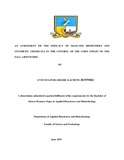Please use this identifier to cite or link to this item:
https://cris.library.msu.ac.zw//handle/11408/3716| Title: | An assessment of the efficacy of selected biopestides and synthetic chemicals in the control of the corn strain of the fall armyworm | Authors: | Kachote, Annunciator Abigirl | Keywords: | Army-worm | Issue Date: | 2019 | Publisher: | Midlands State University | Abstract: | The fall armyworm is a devastating pest of maize which has recently reached the African continent. Currently, there are no registered insecticides for FAW control in African countries, except applications allowed through an emergency label, suggesting an urgent need for insecticide screening. A study was carried out at the Department of Research and Specialist Service to investigate the efficacy of selected biopesticides and synthetic chemicals against the fall armyworm. The laboratory bioassays were carried out at the Entomology Section. Third instar stage fall armyworm larvae were exposed to the biopesticides (Achta, Delfin and Dynamo) and Synthetic Chemicals (Nemesis, Blanket and Vantex). This was done by placing four third instar FAW larvae in each perforated vial together with maize leaves as feed for the larvae and spraying each treatment into a vial at the manufacter’s recommended rate. Recordings of mortality were taken for both biopesticides and synthetic chemicals within a four day period for the synthetic chemicals and a fourteen day period for the biopesticides. Two way ANOVA and Dunnet's test were used to analyse the results. The synthetic chemicals had an influence on larval mortality (p= 0.01). Nemesis was the most effective pesticide causing 93.8% mortality and the least effective was Vantex causing 60% mortality. Resistance of the larvae to Cyhalothrin was thought to be the main reason for its low efficacy. The biopesticides also had an influence on larval mortality (p= 0.417). Dynamo was the most effective causing 84.4% mortality and Achta was the least effective causing 78.1% mortality. The synthetic insecticides and biopesticides that showed high efficacy against FAW larvae can be used as components for integrated pest management (IPM) plans for FAW in Zimbabwe and elsewhere in Africa. | URI: | http://hdl.handle.net/11408/3716 |
| Appears in Collections: | Bachelor Of Science In Applied Biosciences And Biotechnology Honours Degree |
Files in This Item:
| File | Description | Size | Format | |
|---|---|---|---|---|
| AN ASSESSMENT OF THE EFFICACY OF SELECTED BIOPESTIDES AND SYNTHETIC CHEMICALS IN THE CONTROL OF THE CORN STRAIN OF THE FALL ARMYWORM FINAL.pdf | Full Text | 982.92 kB | Adobe PDF |  View/Open |
Page view(s)
122
checked on Jan 14, 2025
Download(s)
222
checked on Jan 14, 2025
Google ScholarTM
Check
Items in MSUIR are protected by copyright, with all rights reserved, unless otherwise indicated.


